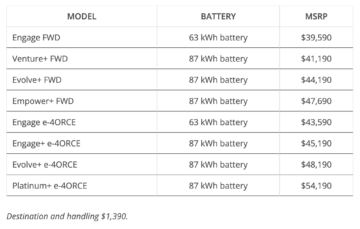Sign up for daily news updates from CleanTechnica on email. Or follow us on Google News!
The solar energy industry of Texas is in a weird situation politically, but that doesn’t seem to stop investors from pumping more green gold into the state’s economy. The latest news is particularly interesting because it illustrates how manufacturers based in other states — and other countries — can leverage renewable energy projects in Texas to turbo-boost their clean power profiles.
A Solar Love Letter From Texas To South Carolina
If you guessed South Carolina is one of those other states, run right out and buy yourself a cigar. Currently, South Carolina places a respectable #14 in a 50-state ranking of installed solar capacity. However, according to records compiled by the Solar Energy Industries Association the state earns a less respectable #22 slot for five-year projected growth in solar capacity.
That’s not good news for electric vehicle manufacturers and other clean tech companies that hope to burnish their green cred by decarbonizing their factories. Fortunately, solar-hungry businesses don’t have to wait for the South Carolina solar pot to boil. They can get credit for new solar projects in other states, by investing in Renewable Energy Certificates.
Despite some concerns over transparency in the REC market, the Rocky Mountain Institute is among the renewable energy advocates that count on RECs to help foster rapid decarbonization, To address the transparency objections, RMI is developing a more rigorous, quantitative approach to measuring the impact of RECs.
With that in mind, let’s look at some REC news from JNA, the South Carolina-based engineering and manufacturing offshoot of the influential Japanese conglomerate JTEKT Corporation.
JNA is new to the CleanTechnica radar, but the company is a familiar face in the US and global automotive and aerospace landscapes, so we’ll probably be hearing more from them as the energy transition gathers steam.
In the latest news, JNA has entered a virtual power purchase agreement under the umbrella of the Spanish renewable energy firm Greenalia. The agreement enables JNA to acquire the REC equivalent of 142.8 megawatts of solar capacity, credited to Greenalia’s new Misae II solar energy project in Childress, Texas.
Make That A Gigantic Solar Energy Love Letter…
Texas has acquired a powerful solar energy profile, so it’s difficult for one project to stand out, but Misae II is one of them.
The power purchase agreement with JNA will help finance the initial 319-megawatt (DC) stage of the project. The solar array will reach 695 megawatts when fully built out, making it one of the biggest solar energy projects in Texas and the entire US, too.
While JNA can’t directly use the electricity from its share of 142.8 megawatts, its share of Misae II represents the equivalent of all the electricity consumption at the company’s North America production facilities, offsetting about 124,600 tons of carbon annually.
…To The World
Greenalia has positioned Misae II as a high impact decarbonization project with global reach, and the JNA power purchase agreement is just the beginning.
When Greenalia inked the JNA deal last November, the company hinted that it would be seeking additional clean power partners in the US and abroad.
“The Misae II project, through which Greenalia will supply energy to JNA within the framework of this agreement, represents an increase in renewable production at a global level, with the consequent contribution to the global decarbonization process,” Greenalia explained.
Sure enough, just last week Greenalia hammered out another virtual power purchase agreement for Misae II. This one is a 50-megawatt arrangement with the firm Aisin Holdings of America, a branch of the Japanese automotive powerhouse Aisin.
If all goes according to plan, the new power purchase agreement could become a model for other Aisin operations. That covers a lot of ground. The parent corporation currently has 200 companies under its umbrella, operating in Central and South America, Asia, Africa, and Europe as well as Japan and North America.
“This VPPA is a critical part of Aisin’s sustainability activities and focus on daily energy reduction activities in our plants, in our homes and in our communities,” emphasized AHA president and CEO Kuzuto Koyama.
“This is the first time any Aisin location in the world has used a VPPA as a long-term source of renewable energy credits to offset CO2 production emissions. This VPPA marks a major step towards Aisin’s CO2 reduction and renewable energy goals as stated in the company’s latest Sustainability Report,” Greenalia explained.
Texas Solar Energy Industry Goes Global, Part I
Greenalia was very busy last week. In addition to announcing the new deal with Aisin, the company reminded everyone that it has been building a 1.9 gigawatt pipeline of energy storage, wind, and solar energy projects in Texas, as part of a 3-gigawatt goal for the US over the coming years.
To help finance the projects, Greenalia just closed on $200 million in three-year credit facilities, which are pre-approved loans that a borrower draws upon as needed, rather than having to submit a new application each time.
The credit arrangement was spearheaded by the Japan-based global firm Nomura Securities International, Inc., which also acted as sole underwriter, lead arranger, and bookrunner.
The deal is significant because it validates Greenalia’s new position as a leading player in the US renewable energy landscape, featuring its operations in Texas.
“Proceeds from the Facilities will enable Greenalia US to finance project equipment, as well as other development and construction expenses, helping to accelerate the development of its portfolio,” the company explains.
The Greenalia deal is also another signal that the global investor community is eager to support renewable energy projects in the US, regardless of political posturing.
“We are excited to partner with Greenalia and believe this partnership will help unlock the full potential of Greenalia’s impressive renewable energy project development platform in the US,” explained Vinod Mukani, who is head of the Nomura Infrastructure & Power Business.
The US-based firm PEI Global Partners Holdings, which assisted in the credit deal, also had some encouraging words for the US solar energy industry. Referring to the credit facilities, PEI partner Schuyler Fabian explained that the credit facilities approach is “designed to meet Greenalia’s development capital needs across an extensive range of projects and technologies including Letters of Credit, equipment costs and other development expenses.”
“This tailored structure, combining both bank and private credit capital, is poised to significantly advance Greenalia’s project pipeline in the coming years,” Fabian emphasized.
Texas Solar Energy Industry Goes Global, Part II
Greenalia is not a one-off for Texas and the REC market. Last week, for example, the leading global automotive interior supplier Toyota Boshoku America, Inc., dropped word that it is purchasing part of the output from the new Texas Solar Nova 1 solar farm in Kent County through RECs. The funds will help the developer, Clearway Energy Group, move on to the second phase of the 452-megawatt project.
“This is TBA’s first renewable energy procurement at scale in the U.S. and will enable the company to effectively offset 100% of its annual electricity consumption in its U.S. and Canada facilities with renewable energy,” TBA explains.
Between Greenalia and Clearway, that’s a neat demonstration of the ways in which wind and solar energy investors continue to claw their way into Texas, despite new state laws aimed at keeping them out.
Public officials in Texas are front and center in a multi-state legal campaign against ESG (environment, social, governance) investing, leveraging a 2021 law aimed specifically at protecting fossil energy stakeholders.
That doesn’t seem to be working, so now talk is turning to a sort of Brexit, only with a T for Texas. It’s unclear how that would impact the REC market, but it would throw a monkey wrench into upcoming plans for hardening the Texas grid against the growing threat of extreme weather events.
ERCOT, the state’s grid operator, is looking forward to a major new transmission line, enabling it to draw from power resources in Louisiana and Mississippi (or vice versa) in case of severe weather and other emergencies. Construction will reportedly get under way in 2026 with completion anticipated in 2029, so stay tuned for more on that.
Follow me @tinamcasey on Bluesky, Threads, Post, and LinkedIn.
Photo (cropped): Misae II Solar Park in Texas, courtesy of Greenalia.
Have a tip for CleanTechnica? Want to advertise? Want to suggest a guest for our CleanTech Talk podcast? Contact us here.
Latest CleanTechnica TV Video
[embedded content]
I don’t like paywalls. You don’t like paywalls. Who likes paywalls? Here at CleanTechnica, we implemented a limited paywall for a while, but it always felt wrong — and it was always tough to decide what we should put behind there. In theory, your most exclusive and best content goes behind a paywall. But then fewer people read it!! So, we’ve decided to completely nix paywalls here at CleanTechnica. But…
Thank you!
Advertisement
CleanTechnica uses affiliate links. See our policy here.
- SEO Powered Content & PR Distribution. Get Amplified Today.
- PlatoData.Network Vertical Generative Ai. Empower Yourself. Access Here.
- PlatoAiStream. Web3 Intelligence. Knowledge Amplified. Access Here.
- PlatoESG. Carbon, CleanTech, Energy, Environment, Solar, Waste Management. Access Here.
- PlatoHealth. Biotech and Clinical Trials Intelligence. Access Here.
- Source: https://cleantechnica.com/2024/02/18/the-texas-solar-energy-revolution-is-going-global/
- :has
- :is
- :not
- $UP
- 1
- 15%
- 200
- 2021
- 2026
- 36
- 8
- 9
- a
- About
- abroad
- accelerate
- According
- acquire
- acquired
- across
- activities
- addition
- Additional
- address
- advance
- Advertise
- advocates
- Affiliate
- africa
- against
- Agreement
- aimed
- All
- also
- always
- america
- among
- an
- and
- Announcing
- annual
- Annually
- Another
- Anticipated
- any
- Application
- approach
- ARE
- arrangement
- Array
- AS
- asia
- assisted
- Association
- At
- automotive
- Bank
- based
- BE
- because
- become
- been
- Beginning
- behind
- believe
- BEST
- Biggest
- Bit
- bluesky
- boil
- borrower
- both
- Branch
- Brexit
- Building
- built
- business
- businesses
- busy
- but
- buy
- by
- CAN
- Can Get
- Canada
- Capacity
- capital
- carbon
- Carolina
- case
- Center
- central
- ceo
- certificates
- chip
- cigar
- clean
- cleantech
- Cleantech Talk
- closed
- CO
- co2
- combining
- coming
- coming years
- Communities
- community
- Companies
- company
- Company’s
- compiled
- completely
- completion
- Concerns
- conglomerate
- construction
- consumption
- content
- continue
- contribution
- CORPORATION
- Costs
- could
- count
- countries
- county
- courtesy
- covers
- Cred
- credit
- Credits
- critical
- Currently
- daily
- dc
- deal
- decarbonization
- decide
- decided
- Despite
- Developer
- developing
- Development
- difficult
- directly
- Doesn’t
- don
- Dont
- draw
- draws
- dropped
- each
- eager
- economy
- effectively
- Electric
- electric vehicle
- electricity
- electricity consumption
- embedded
- Emissions
- emphasized
- enable
- enables
- enabling
- encouraging
- energy
- energy projects
- Engineering
- enough
- entered
- Entire
- Environment
- equipment
- Equivalent
- ESG
- Ether (ETH)
- Europe
- events
- everyone
- example
- excited
- Exclusive
- expenses
- explained
- Explains
- extensive
- extreme
- Face
- facilities
- factories
- familiar
- Featuring
- felt
- fewer
- finance
- Firm
- First
- first time
- Focus
- For
- Fortunately
- Forward
- fossil
- Foster
- Framework
- from
- front
- full
- fully
- funds
- get
- Global
- goal
- Goals
- Goes
- Gold
- good
- governance
- Green
- Grid
- Ground
- Group
- Growing
- Growth
- guessed
- Guest
- had
- hammered
- Have
- having
- head
- hearing
- help
- helping
- here
- High
- hinted
- Holdings
- Homes
- hope
- How
- However
- HTML
- HTTPS
- if
- ii
- illustrates
- Impact
- implemented
- impressive
- in
- In other
- Inc.
- Including
- Increase
- independent
- industries
- industry
- Influential
- Infrastructure
- initial
- inked
- Institute
- interesting
- interior
- International
- into
- investing
- investor
- Investors
- IT
- ITS
- Japan
- Japanese
- jpg
- just
- keeping
- landscapes
- Last
- latest
- Latest News
- lead
- leading
- Legal
- less
- letter
- Level
- Leverage
- leveraging
- like
- likes
- Limited
- links
- Loans
- location
- long-term
- Look
- looking
- Lot
- Louisiana
- love
- major
- Making
- Manufacturers
- manufacturing
- Market
- max-width
- me
- measuring
- Media
- Meet
- mind
- Mississippi
- model
- more
- most
- Mountain
- move
- Neat
- Need
- needed
- needs
- New
- news
- nomura
- North
- north america
- November
- now
- objections
- of
- officials
- offset
- offsetting
- on
- ONE
- only
- operating
- Operations
- operator
- or
- Other
- our
- out
- output
- over
- part
- particularly
- partner
- partners
- Partnership
- People
- phase
- pipeline
- Places
- plan
- plans
- plants
- platform
- plato
- Plato Data Intelligence
- PlatoData
- player
- podcast
- poised
- policy
- politically
- portfolio
- position
- positioned
- Post
- pot
- potential
- power
- powerful
- powerhouse
- president
- private
- PRNewswire
- probably
- process
- procurement
- Production
- Profile
- Profiles
- project
- projected
- projects
- publish
- pumping
- purchase
- Purchase Agreement
- purchasing
- put
- quantitative
- radar
- range
- Ranking
- rather
- reach
- Read
- Reader
- records
- reduction
- referring
- Regardless
- Renewable
- renewable energy
- report
- reportedly
- represents
- Resources
- respectable
- Reuters
- Revolution
- right
- rigorous
- rocky
- Run
- s
- Scale
- Second
- Securities
- see
- seeking
- seem
- severe
- Share
- should
- Signal
- significant
- significantly
- situation
- slot
- So
- Social
- solar
- solar energy
- some
- Source
- South
- South America
- South carolina
- Spanish
- spearheaded
- specifically
- Stage
- stand
- State
- stated
- States
- stay
- Steam
- Step
- Stop
- storage
- Stories
- structure
- submit
- suggest
- supplier
- supply
- support
- Sustainability
- T
- tailored
- Talk
- team
- tech
- tech companies
- Technologies
- texas
- than
- that
- The
- The Projects
- The State
- the world
- their
- Them
- then
- theory
- There.
- they
- this
- those
- threat
- Through
- throw
- time
- tip
- to
- tons
- too
- tough
- towards
- toyota
- transition
- transmission
- Transparency
- tuned
- Turning
- tv
- u.s.
- umbrella
- unclear
- under
- unlock
- upcoming
- Updates
- upon
- us
- use
- used
- uses
- Ve
- vehicle
- versa
- very
- vice
- Video
- Virtual
- wait
- want
- was
- Way..
- ways
- we
- Weather
- week
- WELL
- What
- when
- which
- while
- WHO
- will
- wind
- with
- within
- Word
- words
- working
- world
- would
- Wrench
- write
- Wrong
- years
- you
- Your
- yourself
- youtube
- zephyrnet





